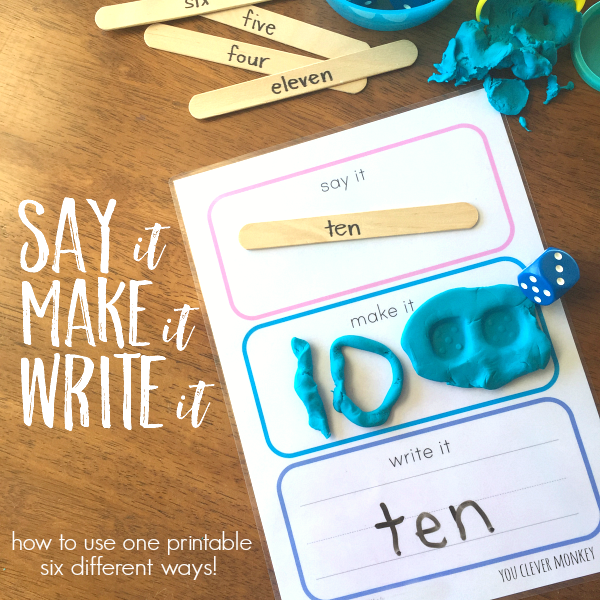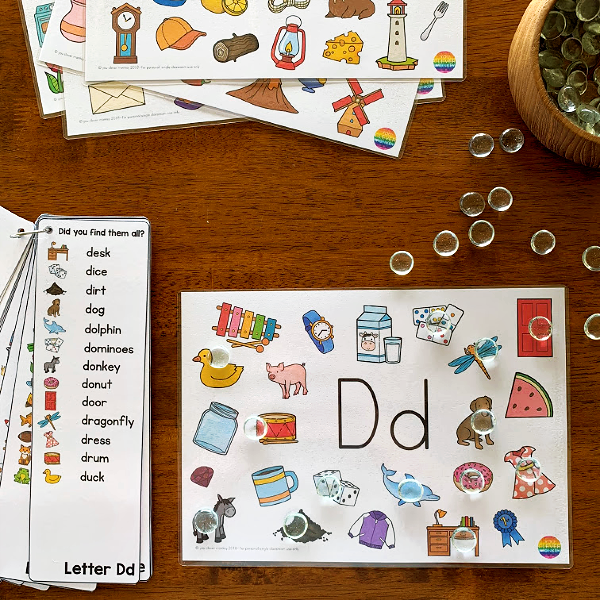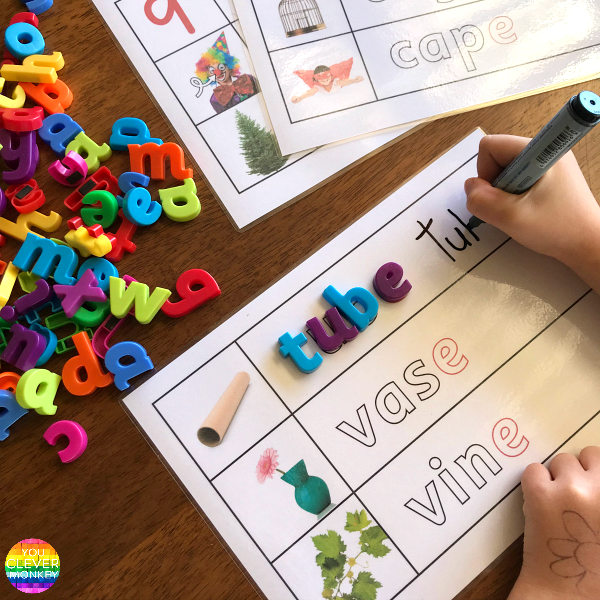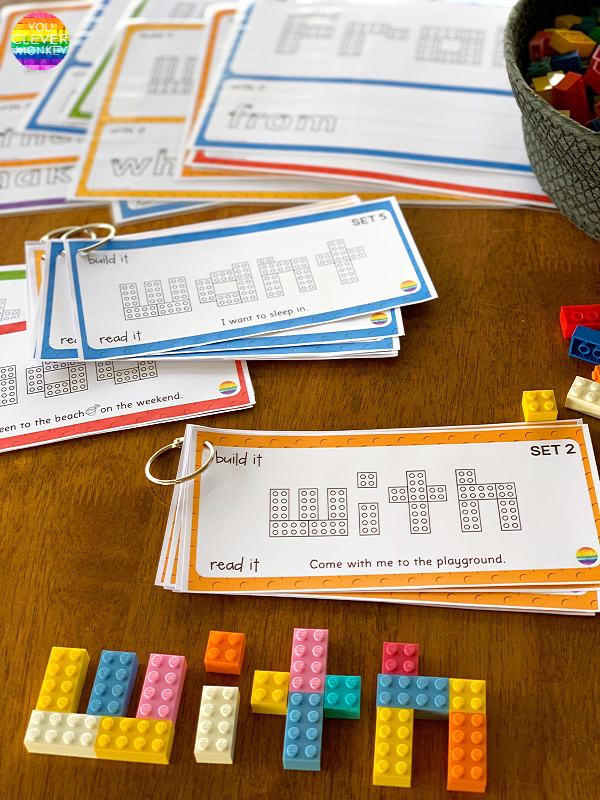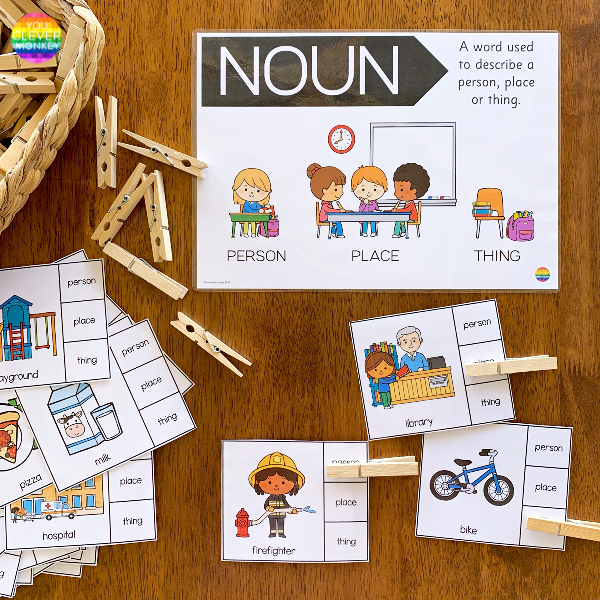Even more literacy center ideas to try in your classroom to help your students learn how to rhyme, recognise syllables, initial letter sounds, high frequency sight words and read and spell CVC words.
After working in preschool, I'm back in the classroom this year and literacy centres are part of our weekly timetable once again.
A couple of years ago I did a round-up of some of the literacy-based activities I was using during our work stations and thought it time to share some of the resources I'm now using with my current class who are aged between 4-7 years.
In the first term at school we focus on building and consolidating phonological awareness skills - syllables, rhyme, beginning letter sounds, name recognition/writing, along with co-operative play and developing letter recognition and building vocabulary. Later in the term we'll start to look at reading and spelling short CVC words (consonant-vowel-consonant), sight words and other parts of speech.
This post contains affiliate links.
Learning to recognise each letter takes time.
With a few keen cutters in my class, I made a straw cutting station for them to use during activity time one week and now the straws form a lovely sensory bin base. This time we hide some more of our magnetic letters in them.
Sensory trays are a great way to engage many learners and can be made from anything - sand, rice, beans, kinetic sand, shredded paper, pom-poms, beads, straws like above. Just fill a small tub or tray and then hide in whatever needs sorting.
Putting the alphabet into the correct order can be another fun way to practice identifying individual letters in your literacy centres.
Have some magnetic letters? Are they all in a mess? I know the ones in my classroom were so we did this letter sort as one of our activties at the start of the school year. You can ask the children to match lower-case to lower-case or make it more challenging by matching the lower-case letters to the upper-case equivalent.
These upper and lower case letter cards are a useful centre for building up letter recognition skill too.
These alphabet puzzles are a handy set for morning tubs or literacy centres at the start of the year.
With two parts for every letter of the alphabet, they show children both upper and lower-case letters along with a single image that begins with the letters beginning sound that needs matching up. It can be a good activity to send home too.
LEGO is always engaging and I can't see us getting rid of our Duplo blocks anytime - not with these free printable letter cards from Wildflower Ramblings to put with them.
For preschoolers, encourage them to make the beginning letter of their name while older children might try to make both upper and lower-case letters or you can target just the letters being taught in your spelling lessons.
Playdough is always popular with this year level so these alphabet mats see a lot of use especially in the first half of the school year.
They're perfect for pre-writers as you can add playdough or loose parts like stones or wix stix to make the letters or print them smaller for tracing cards for those ready to begin writing.
They're perfect for pre-writers as you can add playdough or loose parts like stones or wix stix to make the letters or print them smaller for tracing cards for those ready to begin writing.
Another easy alphabet sort - I made up these letter cards in different fonts. Each letter has the same line of colour running along the bottom to help support children sort them correctly.
COUNTING SYLLABLES
We've done a lot of work in class around syllables - we've clapped syllables, we've sorted syllables, we've used the number of syllables in our names to help work out who the star of the day might be and we keep revising the concept with our literacy centres.
We've used the numbered mats I shared before and sometimes we use baskets to sort our objects by syllables.
I've used these peg cards this term in our centres to help practice counting syllables in longer perhaps unfamiliar words.
I'm always trying to add in manipulatives that build those small hand muscles at this age so these cards are easy to prep - print then add pegs.
You can add a small sticker on the back of each card to make them self-checking.
I'm always trying to add in manipulatives that build those small hand muscles at this age so these cards are easy to prep - print then add pegs.
You can add a small sticker on the back of each card to make them self-checking.
Once everyone's a little more confident with counting syllables, I'll add this syllable BINGO game into our literacy rotations.
It allows us to keep practicing this skill but being a game, engagement is maintained.
LEARNING TO RHYME
Children who can rhyme will become better readers and writers so games that allow children to hear and produce rhyme are often included in our literacy centre rotations.
You'll notice that I tend to come back to the same type of resources over and over again for literacy centres - rocks, sticks, cards. I particularly like these wider plain ice-cream sticks. I used them recently to make these games of rhyming dominoes.
Starting with the first stick in the series, children need to find a word that rhymes to link the sticks. You note I've kept to CVC words to make them easy to decode independently by early readers but I'll often place one strong reader in each group to help things moving if I don't have a teacher's aide during this time.
I saw this game Kaboom! over on The Starr Spangled Planner and thought I'd make a rhyming version.
Simple to play, children take it in turns to remove an ice-cream stick from the cup (words are at the bottom), if they can say a word that rhymes, they keep the stick. If they can't, they must return it to the cup but if they pick out a stick with KABOOM! on it they have to return all their sticks.
YOU MIGHT ALSO LIKE
My students love this CVC word family BINGO game.
We've played it as a whole class and now occasionally use it as a centre to help them practice making rhyming words.
It also helps build social skills within our classroom like turn taking and sportsmanship.
One of my favourite activities for literacy centres are clip cards - perfect for building fine motor skills and literacy skills!
I use them a lot in centres and they need little explaining to get everyone going. These rhyming word ones have been a fun way to practice identifying and producing rhyme.
I use them a lot in centres and they need little explaining to get everyone going. These rhyming word ones have been a fun way to practice identifying and producing rhyme.
Last year at preschool I made these rhyming mats for play so children can use the pins and rubber bands to make the pairs independently. Again perfect for building fine motor skills.
Don't want to use pins without supervision? Swap them out for whiteboard markers or a geoboard with rubberbands.
Later in the school year, I add in these rhyming domino card packs.
They're perfect for small groups to play but they need to be confidently making rhyme to enjoy this game as they need to hold 4-5 cards at a time when playing.
YOU MIGHT ALSO LIKE
BEGINNING LETTER SOUNDS
The school I'm teaching at currently uses the Jolly Phonics program which sees children introduced to a new sound a day. We don't always do an activity the same day to help reinforce the new sound but will incorporate some in our centres particular for those sounds which are proving more difficult to learn.
At the start of the school year, I provide every child with a small tub of playdough so adding playdough mats like these alphabet ones to our centre rotations are simple to organise.
Playdough is perfect for building up fine motor strength as are clothes pegs.
These beginning sound cards ask children to work out which of the images start with the letter displayed. The real photos are lovely and clear making them easy to work out.
We used pegs to match them and I've added a small sticker to the back of each card to make it easy for the children to check their answer independently.
With every letter of the alphabet they're good to add along with our letter wheels to make it easier to differentiate the task within each group.
When the children are ready we use these alphabet beginning sound mats.
I use these either to help reinforce all the sounds taught towards the end of first term or in batches as we introduce and teach each sound.
SPELLING WORDS
Some of the first words we try to spell independently are CVC words so at the beginning of the school year, we use our literacy centre trays to practice breaking the words into individual sounds then blending them back into words.
I'd bought these alphabet stamps
LEGO is always going to help engage every group so I created these CVC word mats to practice our spelling.
They're made to suit LEGO bricks so the children can direct build the word then practice writing it themselves.
Each year I've had a number of children in my class who have 'learnt' their single letter phonograms yet had difficulty blending them into words.
These Crack The Code Word cards have been a lifesaver as the children are able to access their knowledge of sounds then can practice blending them together to make simple words.
I start with the CVC word cards then introduce the CCVC and CVCC ones when they are ready for more of a challenge.
We all know as Early Years teachers that spelling and reading CVCe words are another step some can struggle with.
As you already know, I love using visuals to help support children as they learn new concepts so resources like these CVCe Word Mats are some of the first I'll introduce to our literacy rotations when we start introducing the alternate vowel sounds.
Children can trace the word, build it or write it making it mutli-sensory.
Other games like CVCe BINGO and these CVCe Puzzle Cards and for reading CVCe words, I love using these clip cards.
SIGHT WORDS
Just like our CVC LEGO Word Mats, this LEGO sight word version is always a popular addition to our literacy centre rotations.
These have made differentiation within our centres easier too as the children can either build directly onto the larger mats and practice their writing or if spelling and reading is the focus, I use these smaller cards instead.
They're perfect for building visual discrimination skills as the children have to build the word with the support of printed image underneath just to match to.
These sight word cards are a quick reading activity to add to centres. I have them already prepped in class for our reading groups and each child knows which set of words they are working on mastering.
In our small groups, they might take it in turns to read the words to each other or make them using either magnetic letters or alphabet beads or stamp the words.
In our small groups, they might take it in turns to read the words to each other or make them using either magnetic letters or alphabet beads or stamp the words.
Of course, anything getting the children moving is popular.
I quite often have a teachers' aide in my classroom so a small group can sometimes work outside. Select some of the sight words they are currently working on and do some rainbow chalk writing outside.
Take a few water spray bottles along too and as a reward for all that writing, call out each sight word and have them squirt water at each of them!
Or take some small bean bags and have children try and throw them on the correct sight word as you call them. Super fun!
PARTS OF SPEECH
Literacy centres are a perfect way to reinforce concepts being taught in other lessons.
We'd been learning about common nouns as these clip cards were one of our centre activities in the weeks after.
These Parts of Speech UNO cards from Teach Starter have been a fun way to practice identifying nouns, verbs and adjectives.
For older children, word work tasks like this Verb Tense Pack can be used to focus in on a particular skill.
Here the children had to find the three verbs - the base word, present tense and past tense then record all three.

Punctuation is another skill that can be practiced in literacy groups.
I encourage the children to quietly read these punctuation clip cards aloud to themselves to hear what punctuation is needed.
I love this compound sentence resource from Lauren Fairclough it was one we did as a whole class firstly then I added it to our literacy centres to help reinforce the different conjunctions we use to help make our sentences more interesting.
DIGRAPHS
Digraphs can be so tricky to learn especially when there's more than one that makes the same sound.
These digraph sorting mats make a frequent appearance in our literacy rotations as they are perfect for exposing young children to new vocabulary in game-based task.
Activities like these digraph sound mazes are always popular too.
I'll often include digraph mini books to make while they are being introduced to each digraph.
These are super easy to prep as you just have to hit print but it can take a bit of practice for the children to know how to fold them and where to cut the paper.
At the start of the first year at school I printed out everyone's name and the children can use these to help them write or make their own names. I used dotted lines and laminated them so they can also trace over their names with whiteboard markers too.
Here we used them to help us write in the out-of-date semolina we used instead of the standard salt or sand tray.
You can use sand trays for any writing practice - names, letters, spelling words, sight words.
That small tub of playdough I bought at the start of the year can be used for name practice too.
I love these Alphabet Letter Beads for making words and have found so many different ways to use them.
I bought two boxes of lower case letters and one box of upper case letters. I'm finding them especially good for children still working out the direction of letters because when they look at their own name they can see clearly when a letter has been threaded the wrong way.
Letter reversals are common at this age so I've also made up some resources to help sort out the pesky 'b' and 'd' confusion.
I've included 'p/q' cards along with visual cues for each letter to help students differentiate which letter makes which sound (b is for bed, d is for dog maybe). You can find the full set of letter reversal cards here.

Older grades are obviously ready for more of a challenge in their writing centres.
Sometimes we'll use our literacy centres to edit work done in class.
Recount writing is an easy place to start as many children can write a simple recount sometime during their first year at school but improving and embellishing upon that story is a task for Year 1 and 2s.
We wrote many different recounts in our writing lessons then used our literacy centres to go back and edit them ahead of the following week's writing lesson.
But coming up with a story can be hard for many children. This Tell Me A Story writing centre helps get the most reluctant writer writing as all the heavy lifting has been done.
The children just have to pick three cards which are all colour coded to provide them with a setting, character and event to sequence into a story.
Of course, they all try to outdo each other with the silliest story but everyone is writing so this pack makes a frequent appearance in our writing centres.



















